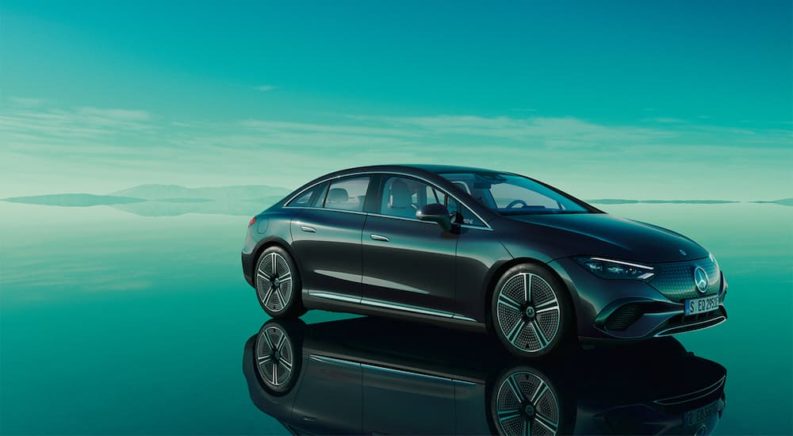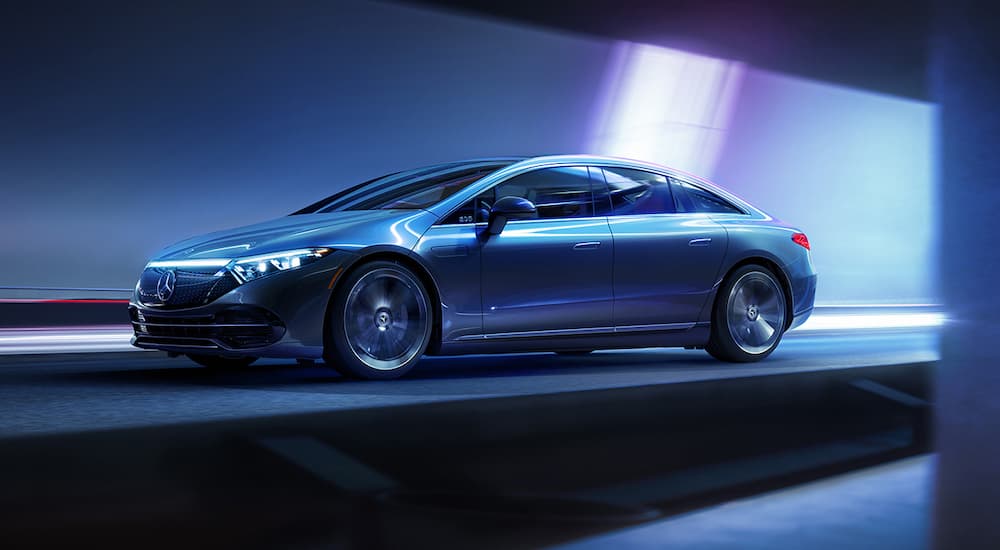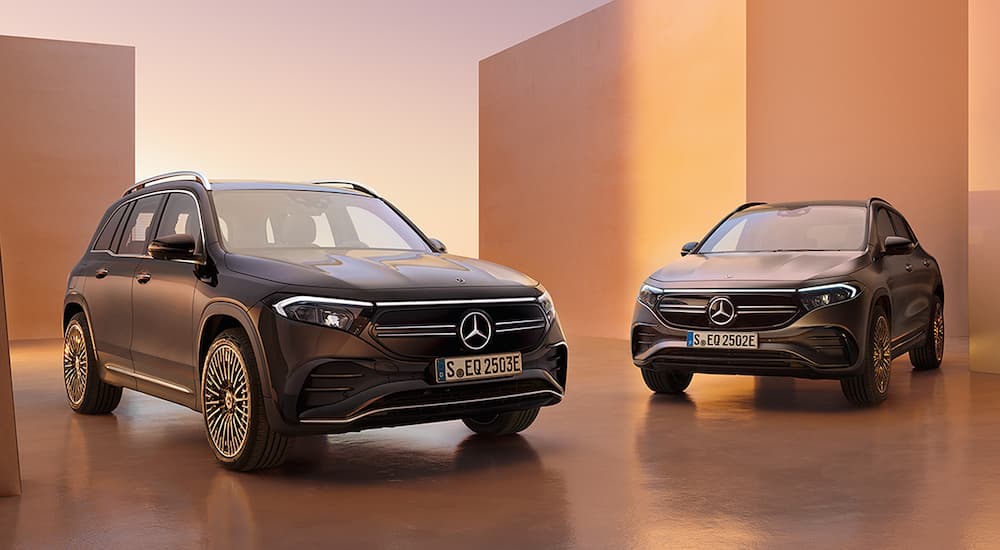Mercedes may be in trouble. This iconic luxury brand seems to be losing its luster, and a quick look at 2021 end-of-year sales figures shows that it currently sits in 4th place for the luxury segment behind Tesla, BMW, and Lexus. While Mercedes still has a healthy lead over Audi in 5th place, it isn’t exactly hot on the heels of the market leader. Something needs to change, and no, renaming the brand’s parent corporation from “Daimler” to “Mercedes-Benz Group” isn’t going to do it for anyone not working at Mercedesstraße in Stuttgart.
Now, in 2022 there is only one obvious answer for any automaker seeking to put some excitement back into its brand: go electric. Even if it wasn’t for the aggressive government mandates aimed at killing gasoline engines in the near future, it is increasingly obvious that electric powertrains are the future of luxury vehicles (you can all stop booing now). Tesla has rocketed out of nowhere to become the best-selling luxury brand in America, and let’s face it, even the Type S isn’t all that luxurious compared to an S-Class. While some of Tesla’s incredible success can be attributed to its unique business model and even more unique CEO, fundamentally, the startup has revealed that there is a huge market for high-performance electric cars.
The question is, can Mercedes actually make high-performance electric cars? There has been no shortage of prophecies that traditional manufacturers will quickly bury the upstart pretender once they get serious and bring their expertise to bear, but so far, that hasn’t happened. Now it’s easy to say that Mercedes and other manufacturers just haven’t gotten serious yet, but it should be remembered that Tesla’s share of the EV market is actually growing, not shrinking. In fact, it looks like Tesla might be the one to bury the traditional manufacturers now that its two new Gigafactories are up and running. In short, Mercedes has its job cut out for it.
Where Is the Urgency?
Mercedes isn’t exactly moving fast when it comes to electrification. Although Mercedes’ first production to hit the market this year was the unveiling of the 2022 Mercedes EQS, the German company has been working on this for a while now. In fact, the all-electric Mercedes-EQ subbrand, along with the Generation EQ concept car, was first announced back in 2016. To put that into perspective, in 2016, Tesla built just over 80,000 vehicles. In 2021, Tesla built over 300,000 vehicles, and Mercedes still didn’t have an EV available in the American market.
A Mercedes EQC based on the Generation EQ concept car was released in 2019 for the European market, but it never made it here to America. While this midsize electric SUV is certainly fast, with over 400 hp and 560 lb-ft of torque from its two electric motors, the rest of its engineering was not so impressive. Weighing in at around 5,400 pounds, this is a beast of an SUV, and its estimated 220-mile range is definitely nothing to write home about. Not when a base Tesla Model X has 670 horsepower and 348 miles of range. In hindsight, it definitely made sense to keep the EQC in Europe, where higher subsidies and stricter mandates made it a more viable choice for drivers.
Now, the new 2022 Mercedes EQS has hit the scene. Like Lucid and even Tesla itself, the new Mercedes strategy seems to be starting with the best of the best and filling out the lower levels of the lineup later. Letting your flagship model show the flag and build brand reputation is not a bad strategy at all—more affordable models can later capitalize on it; however, it’s a strategy that only works if people are actually impressed by your flagship. A car like the Tesla Model S Plaid with its 2-second 0-60 time or the Lucid Air Dream with its 520 miles of range is bound to catch anyone’s attention. The Mercedes EQS, not so much–and not just because of its incredibly generic name.
Where’s the Performance?
The interior of the EQS is the definition of 21st-century luxury. In the top-trim EQS 580, the engine dash is a seamless collection of high-resolution screens for the driver and passenger, all surrounded with soft 64-color ambient cabin lighting and plush leather upholstery. Mercedes knows how to do old-world luxury with a modern twist. The problems come when you start examining the rest of the vehicle. Put simply, the EQS just doesn’t have what it takes to hang with the latest models from the EV startups.
With 516 hp and 611 lb-ft of torque, the EQS simply isn’t in the same class as the 1,000+ hp monsters from Tesla and Lucid. In fact, it is barely an improvement over the 496 hp and 516 lb-ft of torque found in the gasoline-powered S 580. Now, you can argue that the EQS is a full-size luxury sedan and not a drag racer, but when you find yourself explaining why your flagship sedan is less than half as powerful as the competition, it might be time to rethink your strategy. Unfortunately, it gets worse when you look at some other performance figures.
First, the curb weight of 5,888 pounds. That’s 1,113 pounds heavier than the S 580. Now, battery packs are heavy, but the Tesla Model S Plaid tips the scale at just 4,842 pounds. Even the more luxurious Lucid Air is a good quarter-ton lighter than the EQS. Such a huge weight difference is the direct result of Mercedes’s less mature EV technology, which requires the use of larger battery packs and motors to achieve acceptable performance. While this inefficiency can be found in every aspect of the EQS drivetrain, it is most obvious when you look at battery performance.
Despite its mediocre 350 mile range, the EQS uses a massive 107.8 kWh battery pack. Meanwhile, the Model S gets 405 miles of range out of a 95 kWh pack. It’s true that Lucid uses an even larger pack than Mercedes, but the Air gets 520 miles of range out of its 118 kWh. Putting things another way, Tesla and Lucid are getting 4.3-4.4 miles of range per kWh, while Mercedes is only getting 3.2 miles per kWh. That is pretty bad, but Tesla and Lucid are both EV powerhouses. Unfortunately, Mercedes is also lagging behind other traditional manufacturers–the BMW i4 gets an estimated 301 miles out of an 80.7 kWh pack, or 3.7 miles per kWh.
Is Reputation Enough?
For the last decade, EVs have been something coming in the future. But while automotive icons like Mercedes made grand proclamations about switching to electric vehicles in the coming years, new brands like Tesla and Lucid were making that future a reality. Now, electric cars make up a substantial portion of the luxury market, and Mercedes is scrambling to make good on its promises. However, they appear to be discovering that while electric and gasoline vehicles may look the same on the outside, the expertise needed to design a world-class, gasoline-powered luxury car isn’t as transferable to the EV world as everyone expected.
Now, Mercedes isn’t going to disappear tomorrow—gasoline cars will still be a part of the market for many years to come, and the reputation that it built over the past 120 years isn’t going to be forgotten any time soon. However, reputation is a fickle thing in the luxury segment–just ask Cadillac, Lincoln, or Chrysler. Just as social and technological changes allowed the German luxury brands to depose the American luxury brands in the 1980s, the EV revolution may well upend the current order. If Mercedes doesn’t manage to seriously step up its EV game soon, it runs the risk of becoming another once-prestigious brand clinging to past glories.






